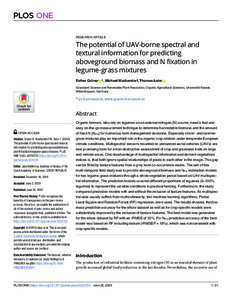The potential of UAV-borne spectral and textural information for predicting aboveground biomass and N fixation in legume-grass mixtures
| dc.date.accessioned | 2020-07-03T13:38:22Z | |
| dc.date.available | 2020-07-03T13:38:22Z | |
| dc.date.issued | 2020-06-25 | |
| dc.identifier | doi:10.17170/kobra-202007021395 | |
| dc.identifier.uri | http://hdl.handle.net/123456789/11627 | |
| dc.description.sponsorship | Gefördert durch den Publikationsfonds der Universität Kassel | ger |
| dc.language.iso | eng | eng |
| dc.rights | Namensnennung 4.0 International | * |
| dc.rights.uri | http://creativecommons.org/licenses/by/4.0/ | * |
| dc.subject.ddc | 630 | |
| dc.title | The potential of UAV-borne spectral and textural information for predicting aboveground biomass and N fixation in legume-grass mixtures | eng |
| dc.type | Aufsatz | |
| dcterms.abstract | Organic farmers, who rely on legumes as an external nitrogen (N) source, need a fast and easy on-the-go measurement technique to determine harvestable biomass and the amount of fixed N (NFix) for numerous farm management decisions. Especially clover- and lucerne-grass mixtures play an important role in the organic crop rotation under temperate European climate conditions. Multispectral sensors mounted on unmanned aerial vehicles (UAVs) are new promising tools for a non-destructive assessment of crop and grassland traits on large and remote areas. One disadvantage of multispectral information and derived vegetations indices is, that both ignore spatial relationships of pixels to each other in the image. This gap can be filled by texture features from a grey level co-occurrence matrix. The aim of this multi-temporal field study was to provide aboveground biomass and NFix estimation models for two legume-grass mixtures through a whole vegetation period based on UAV multispectral information. The prediction models covered different proportions of legumes (0–100% legumes) to represent the variable conditions in practical farming. Furthermore, the study compared prediction models with and without the inclusion of texture features. As multispectral data usually suffers from multicollinearity, two machine learning algorithms, Partial Least Square and Random Forest (RF) regression, were used. The results showed, that biomass prediction accuracy for the whole dataset as well as for crop-specific models were substantially improved by the inclusion of texture features. The best model was generated for the whole dataset by RF with an rRMSE of 10%. For NFix prediction accuracy of the best model was based on RF including texture (rRMSEP = 18%), which was not consistent with crop specific models. | eng |
| dcterms.accessRights | open access | |
| dcterms.creator | Grüner, Esther | |
| dcterms.creator | Wachendorf, Michael | |
| dcterms.creator | Astor, Thomas | |
| dc.relation.doi | doi:10.1371/journal.pone.0234703 | |
| dc.subject.swd | Hülsenfrüchtleranbau | ger |
| dc.subject.swd | Stickstoffbedarf | ger |
| dc.subject.swd | Biomasse | ger |
| dc.subject.swd | Flugkörper | ger |
| dc.type.version | publishedVersion | |
| dcterms.source.identifier | EISSN 1932-6203 | |
| dcterms.source.issue | Issue 6 | |
| dcterms.source.journal | Plos One | eng |
| dcterms.source.pageinfo | e0234703 | |
| dcterms.source.volume | Volume 15 | |
| kup.iskup | false |
Dateien zu dieser Ressource
Das Dokument erscheint in:
-
Artikel [1104]


